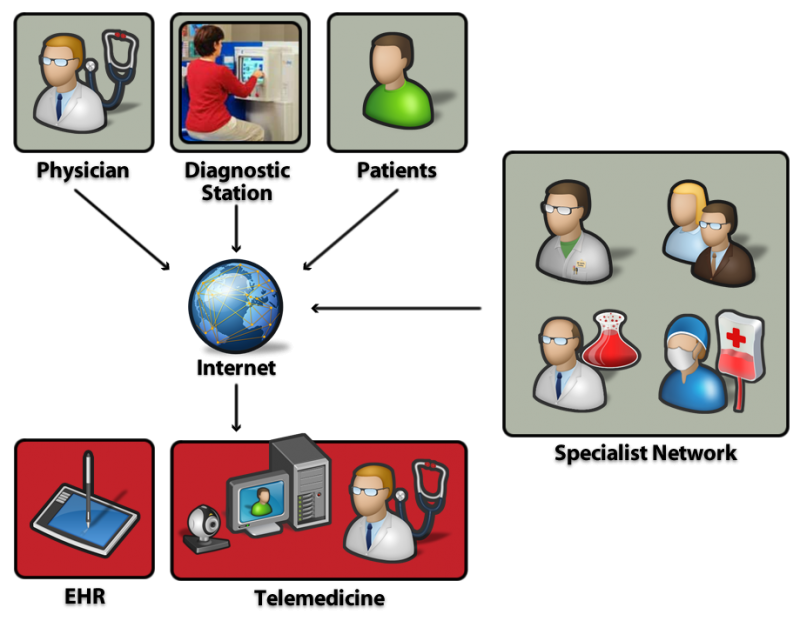
Definition:
Telemedicine is the use of medical information exchanged from one site to another via electronic communications to improve patients' health status. Closely associated with telemedicine is the term "telehealth," which is often used to encompass a broader definition of remote healthcare that does not always involve clinical services. Videoconferencing, transmission of still images, e-health including patient portals, remote monitoring of vital signs, continuing medical education and nursing call centers are all considered part of telemedicine and telehealth.
Telemedicine is not a separate medical specialty. Products and services related to telemedicine are often part of a larger investment by health care institutions in either information technology or the delivery of clinical care. Even in the reimbursement fee structure, there is usually no distinction made between services provided on site and those provided through telemedicine and often no separate coding required for billing of remote services.
Telemedicine encompasses different types of programs and services provided for the patient. In our company, we have components for different providers and consumers.
Telemedicine Services:
- Specialist referral services typically involves of a specialist assisting a general practitioner in rendering a diagnosis. This may involve a patient "seeing" a specialist over a live, remote consult or the transmission of diagnostic images and/or video along with patient data to a specialist for viewing later. Recent surveys have shown a rapid increase in the number of specialty and subspecialty areas that have successfully used telemedicine. Radiology continues to make the greatest use of telemedicine with thousands of images "read" by remote providers each year. Other major specialty areas include: dermatology, ophthalmology, mental health, cardiology and pathology. According to reports and studies, almost 50 different medical subspecialties have successfully used telemedicine.
- Patient consultations using telecommunications to provide medical data, which may include audio, still or live images, between a patient and a health professional for use in rendering a diagnosis and treatment plan. This might originate from a remote clinic to a physician's office using a direct transmission link or may include communicating over the Web.
- Remote patient monitoring uses devices to remotely collect and send data to a monitoring station for interpretation. Such "home telehealth" applications might include a specific vital sign, such as blood glucose or heart ECG or a variety of indicators for homebound patients. Such services can be used to supplement the use of visiting nurses.
- Medical education provides continuing medical education credits for health professionals and special medical education seminars for targeted groups in remote locations.
- Consumer medical and health information includes the use of the Internet for consumers to obtain specialized health information and on-line discussion groups to provide peer-to-peer support.

Delivery Mechanisms:
- Networked programs link tertiary care hospitals and clinics with outlying clinics and community health centers in rural or suburban areas. The links may use dedicated high-speed lines or the Internet for telecommunication links between sites. Studies by the several agencies within the U.S. Department of Health and Human Services, private vendors and assessments by ATA of its membership place the number of existing telemedicine networks in the United States at roughly 200. These programs involve close to 2,000 medical institutions throughout the country. Of these programs, it is estimated that about half (100) are actively providing patient care services on a daily basis. The others are only occasionally used for patient care and are primarily for administrative or educational use.
- Point-to-point connections using private networks are used by hospitals and clinics that deliver services directly or contract out specialty services to independent medical service providers at ambulatory care sites. Radiology, mental health and even intensive care services are being provided under contract using telemedicine to delivery the services.
- Primary or specialty care to the home connections involves connecting primary care providers, specialists and home health nurses with patients over single line phone-video systems for interactive clinical consultations.
- Home to monitoring center links are used for cardiac, pulmonary or fetal monitoring, home care and related services that provide care to patients in the home. Often normal phone lines are used to communicate directly between the patient and the center although some systems use the Internet.
- Web-based e-health patient service sites provide direct consumer outreach and services over the Internet. Under telemedicine, these include those sites that provide direct patient care.

















